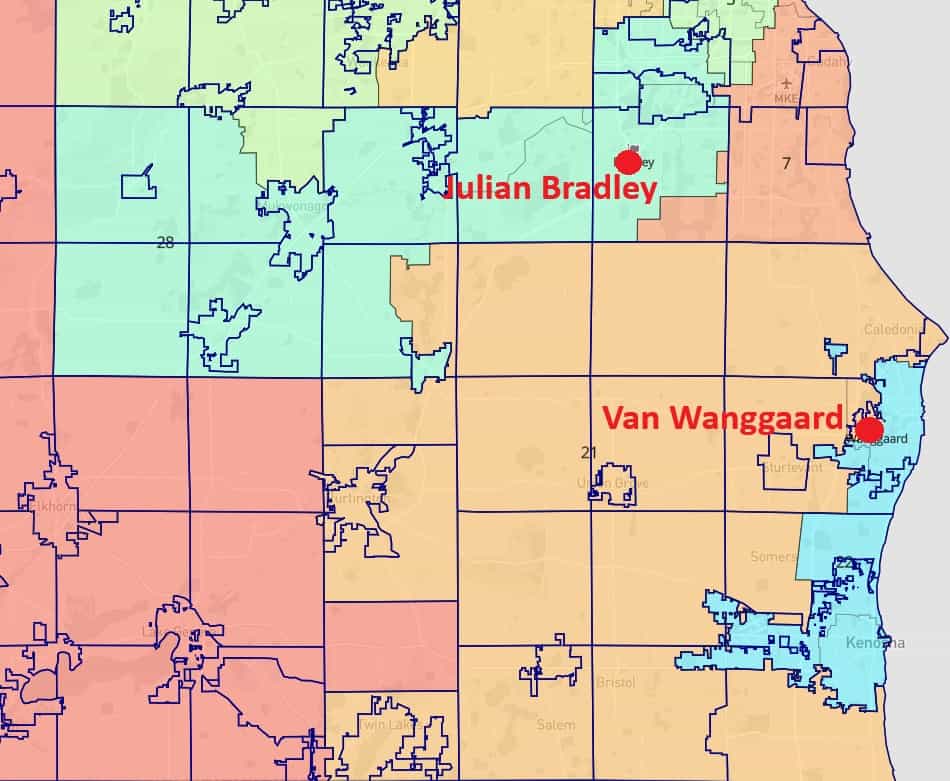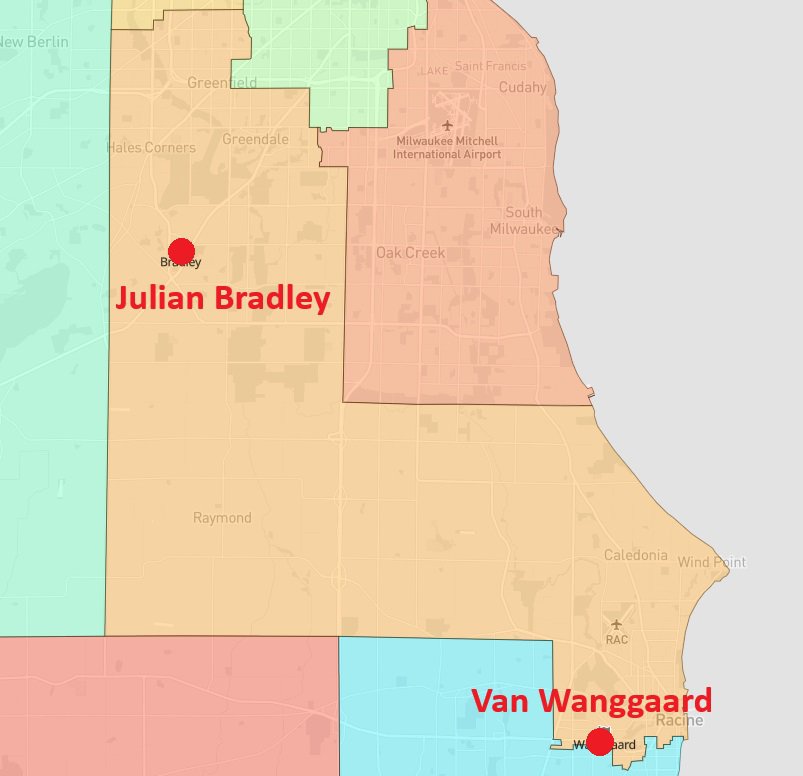Evers’ maps attempt to roll back racial progress in the Wisconsin Legislature.
Gov. Tony Evers’ new partisan legislative redistricting map targets one of only two Black Republican legislators in Wisconsin history, state Sen. Julian Bradley, by forcing him out of the state Legislature for at least two years.
That’s according to Wisconsin Right Now’s review of Evers’ map, which he submitted to the liberal-controlled state Supreme Court on Friday. We have been writing a series of articles exposing the impact of Evers’ map; the governor has falsely told the public that his maps are “fair” and non-partisan.

“My very existence frustrates their narrative,” Bradley told Wisconsin Right Now. He is one of the strongest advocates for public safety in the Wisconsin Legislature. Bradley was previously named the Milwaukee Police Association Legislator of the Year. Wisconsin Right Now named him to its Wall of Fame for his advocacy for public safety.
“It feels personal. It feels very strategic,” he said.
For 100 years, there were no black Republicans in either chamber of the Wisconsin Legislature. In fact, there has only ever been one other – Lucian Palmer in 1906. In addition to being one of 2 black Republican legislators in Wisconsin history, Julian Bradley is the first black Republican state senator in the history of the state.

Julian Bradley won the 28th state Senate seat in 2020 in the Milwaukee metropolitan area, in a majority white district, with the endorsement of former Republican Gov. Scott Walker. Now Wisconsin’s Democratic governor, Tony Evers, is trying to roll back that historical progress. State Senate terms are every four years.
Bradley confirmed in an exclusive interview with Wisconsin Right Now that Evers’ new map targets Bradley in two ways. We also confirmed the information using mapping software.
Here’s what Evers’ map does:
1) It moves Bradley out of his 28th Senate district and into the 21st Senate District, which is currently occupied by another Republican, state Sen. Van Wanggaard, the majority caucus chair. This move would pit Bradley against Van Wanggaard in a Republican primary. We obtained Bradley’s home address from Bradley himself, and Van Wanggaard’s home address through campaign finance reports and data mining sites.
Current Map of District 28 (Bradley) and District 21 (Wanggaard)

Gov. Evers Proposed Map of District 21

As with Bradley, Van Wanggaard, a former police officer, often deals with public safety issues. He has served off-and-on in the state Legislature since 2010. Both Bradley and Wanggaard are Republicans.
Van Wanggaard did not return several calls seeking comment.
2) However, Bradley’s current district is an even-numbered district, which means he would have been up for re-election in November. However, Van Wanggaard’s district is odd-numbered.
That means that, if Evers’ map is chosen, Bradley would be forced out of the Legislature for two years because he couldn’t run again where he lives until 2026. He would essentially be a former legislator floating without a district for two years.
This is an extremely partisan move that would eradicate voters’ wishes – which was to be represented by Julian Bradley. It also would reduce the number of black legislators.
The Machiavellian maneuver accomplishes two partisan goals for Democrats and Evers, even as they lie that their maps are not partisan:
1) It creates an open seat in November for Bradley’s old district, removing the advantage of incumbency. It’s widely believed Democrats are already recruiting candidates for the expected-to-be new open seats they are trying to create all over the state.
2) It forces the state’s only black Republican senator in Wisconsin history out of the Legislature for at least two years.
The only other option would be for Bradley to move, but it’s a tall order to expect people to move, especially in the extremely rushed timeframe established by the liberal-controlled court.
“I think it’s petty,” Bradley said.
He said that past maps had few Republican incumbent pairings in them. Historically, it’s “incredibly unusual,” he said. “It seems very intentional.”
Referring to liberal Justice Janet Protasiewicz, he said, “Nobody should be surprised. Janet said this is what they would do.”
Protasiewicz’s prejudging of the redistricting case (she called the current maps “rigged”) is an issue Republicans hope the US Supreme Court will take up since Protasiewicz accepted $10 million from the state Democratic Party for her campaign. An alleged constitutional issue due to the rushed timeframe is another angle conservatives are expected to pursue with SCOTUS.
Evers’ maps are one of seven sets of maps, five Democratic favoring, that were submitted Friday to the liberal court, which tossed out the current Republican Legislature-drawn maps right after Protasiewicz took office, eradicating previous court doctrine and precedents to do so.
In its decision, the court fixated on the inclusion of “municipal islands,” which are just inconsequential pieces of annexed land with few people on them. The court said they were unconstitutional even though it had previously found that they weren’t (and Evers included them in his previous maps). However, many of Evers’ mapping decisions appear to have nothing to do with municipal islands. The court also ruled that the maps should be decided based on “partisan impact.”
The court then chose two hand-picked out-of-state consultants to review the submitted maps and make a recommendation to the court. This is supposed to happen at warp speed, by Feb. 1. The court will then choose the new maps by March 1.
Thus, it’s possible that Evers’ maps won’t be chosen. It’s also possible that they will. Either way, we believe that the public should be educated about what Evers is trying to do through his maps submission, especially because he is falsely claiming his maps are not partisan gerrymanders.
We have focused on mostly analyzing Evers’ maps because of the time constraints put on everyone by the state Supreme Court’s rushed timeframe – Feb. 1. Furthermore, as the governor, we believe that the public would be particularly interested in his proposal, as he also has a lot of sway due to his position.
The Legislature’s maps make the least changes. They simply dissolve the municipal islands into surrounding districts. In contrast, Evers’ maps pit approximately 35 Republican representatives and senators against each other and only two pairs of Democrats. Some other Republicans are paired against Democrats in Evers’ maps, which also redraws districts all over the state to remove the power of incumbency and make swing districts more competitive for Democrats. A preliminary review of some of the other maps show they also contain a number of Republican incumbent pairings.
According to Bradley, he lives less than five miles from his old district in the Evers’ maps. “I’ve been drawn out,” he said. “It’s pretty clear they didn’t want me in it. I think it’s very strategic on their behalf.”
Bradley confirmed that the 21st Senate District is not on the ballot in November. “I would not be able to run for re-election for two more years,” he said, under Evers’ maps.
“It’s disappointing that they don’t want to let voters decide. That the Supreme Court is making that decision.”
Table of Contents
















![WATCH: Elon Musk Town Hall Rally in Green Bay [FULL Video]](https://www.wisconsinrightnow.com/wp-content/uploads/2022/04/Elon_Musk_3018710552-356x220.jpg)



![The Wisconsin DOJ’s ‘Unlawful’ Lawman [WRN Voices] josh kaul](https://www.wisconsinrightnow.com/wp-content/uploads/2025/03/MixCollage-29-Mar-2025-08-48-PM-2468-356x220.jpg)













